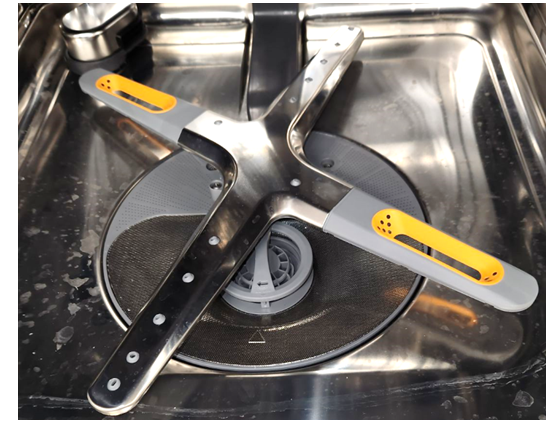dishwasher
Noise
Click on the Steps below to jump directly to that section:
**NOTICE**
Wiring Colors, Connectors, and Pins will vary by model/product code. Always be sure to download and use the service manual for your specific model.
For Test Mode procedures use this link and input your specific model: https://lgtestmodes.com/
Confirm Proper Installation
Check that the tub is level from front to back, remove the lower rack and pour 169 oz. (5 L) of water into the bottom of the tub. The water level should be near the center of both tub lower indentations at the front. A poor installation can creat noisy operation.

Make sure the unit is in the center of its installation place.

Use a wrench to adjust the front feet up or down.

Noise When Filling
If the noise is made during fill, check the inlet valve, the water volume can cause a whistling noise louder or quieter depending on the volume of water, you may adjust out of this with the customers water supply valve. Chattering and humming are also possible noise of a defective water valve.

Water hammer is usually caused in high pressure (e.g. main pressure) water systems either when a tap is turned off quickly, or by fast-acting solenoid valves, which suddenly stop the water moving through the pipes and sets up a shock wave through the water, causing the pipes to vibrate and shudder. This is not an issue with the dishwasher.

Noise When Washing
A defective wash motor can make abnormal sounds as well, this can be verified in a test mode, or express cycle.

When the dispenser pops open it can make a sound that may be different to the customer, it can be tested in test mode.

Rattling noises can be caused by improperly loaded dishes or a loose or clogged filter. Ensure the dishwasher is properly loaded. Utensils hanging out of the rack can hit the spray nozzles or other dishes while a cycle is running. Moving dishes around in the racks so they are secure can prevent this from happening.

A loose or damaged spray arm can cause abnormal noises.

Noise When Draining
Check the drain pump for debris or damage that can cause noise.

Make sure the drain hose is installed correctly and clear of obstructions.

Other Noises
If the Water Guide assembly is loose it will vibrate causing a knocking sound.



If no abnormal noise is found advise the Customer of normal noises that may be heard.
While LG dishwashers are designed to operate quietly, different noises can occur periodically while the unit is in operation. While some noises can be concerning, most are considered part of normal operation.
Check for Service Bulletins for your specific model.